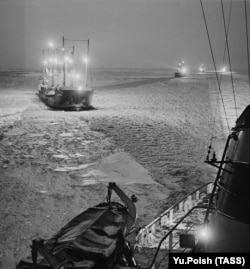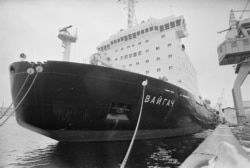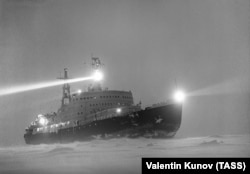Russia operates the world’s largest fleet of major ice-breaking ships and, in December, the country began sea tests for the most powerful icebreaker ever built.
The trials cap a long history of cracking ice for both economic and military advantage in arctic waters.
The Yermak, was the first ship tough enough to crack through polar ice near the North Pole. The vessel was built in England for the Russian government in 1899.
The Yermak (right) crunching through sea ice to rescue a trapped Russian battleship in 1900. The steam-powered icebreaker was initially driven by four propellers -- three at the rear and one in the front -- setting the stage for the further development of massively powerful vessels that could open icy sailing routes.
After the 1917 Bolshevik Revolution, ice-breaking ships took on new relevance as an increasingly isolated Soviet Union looked towards its icy northern seas as the only sea route from Europe to Asia that is entirely within Soviet waters.
Soviet icebreakers were used to clear a path for more fragile merchant vessels, like this convoy in the Baltic Sea. In 1940, the Soviets also gave an ice-breaking escort through the northeast passage for the Nazi battleship Komet, which traveled from Europe all the way into the Pacific, where the vessel wreaked havoc on Allied shipping.
Many icebreakers feature a distinctive spoon-shaped bow and all are built with a toughened hull and internal frame. The rounded bow is designed to slide over sea ice…
…and break through with the enormous weight of the ship above, much as a karate expert hand-chops through blocks of wood. Modern icebreaker hulls are also coated with a slippery layer of resin to reduce friction with the ice.
By 1957, several countries had powerful icebreakers in use but the launch that year of the Soviet icebreaker Lenin (pictured during an arctic expedition in 1961) marked the beginning of the nuclear era for icebreakers. Russia remains the only country with nuclear-powered icebreakers in use.
A technician testing radiation levels near the nuclear reactor for the Lenin in 1962. Nuclear-powered vessels are expensive to produce and maintain but can sail for years without needing to be refueled -- a key factor in the sparsely populated polar regions.
Tourists from Hong Kong pose in front of the Lenin in Murmansk in 2019. The vessel, which suffered two dangerous malfunctions with its reactor during her career, was retired from service in 1989 and now serves as a museum ship.
A polar bear cub aboard the Arktika icebreaker. In 1977, the nuclear-powered ship became the first surface vessel to reach the North Pole.
The Arktika, as well as her sister ships of the same class, feature a prow that is 50 centimeters of solid steel that can crack through ice up to 5 meters thick.
A nuclear reactor weighing nearly 200 tons being installed in a Soviet-era icebreaker. A full day of grinding through thick ice uses up just 300 grams of uranium in a nuclear icebreaker, compared to around 100 tons of fuel for an equivalent diesel-powered vessel.
Crew members relaxing inside a heated swimming pool aboard the Arktika in 1977.
The engine room inside the nuclear-powered Rossiya icebreaker in 1986. As well as powering the vessels’ propellers, nuclear reactors supply all electricity and heating.
A Saudi man prays at the North Pole in 1990. Since the collapse of the Soviet Union in 1991, some of Russia’s nuclear-powered fleet have run a profitable side job ferrying wealthy tourists to the top of the Earth.
The nuclear-powered 50 Years Of Victory icebreaker made five trips carrying tourists to the North Pole in 2018. For the 2020 season, tickets for the unusual cruise start at $30,995 per person.
But the enormous resources Russia is currently pouring into its nuclear ice-breaking fleet will increase sea traffic along the northern sea route and aid in the militarization of the Arctic, where Russia maintains several bases. The Arctic Ocean is predicted to hold around a quarter of the world’s untapped oil and gas.
In December 2019, the Arktika (pictured leaving St. Petersburg), the world’s largest and most powerful icebreaker, underwent tests in the Gulf of Finland. The ship is scheduled to enter service in the summer of 2020.



















